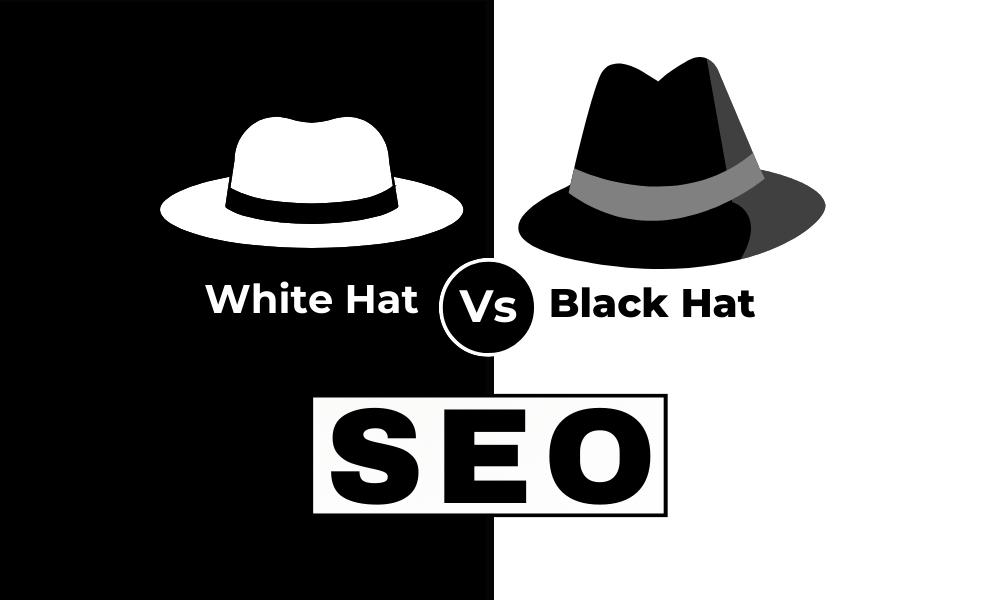In the realm of search engine optimization (SEO), it’s crucial to comprehend the distinction between white hat SEO and black hat SEO techniques. These terms denote the ethical and unethical SEO practices used to optimize websites for search engines. While white hat search engine optimization focuses on adhering to search engine guidelines and delivering value to users, black hat SEO involves manipulating search engine algorithms to achieve higher rankings, often compromising user experience.
Table of Contents
Understanding White Hat SEO
White hat SEO, also known as ethical SEO, is a set of practices that align with search engine guidelines and emphasizes on enhancing user experience. It involves crafting high-quality content, optimizing keywords through keyword research, improving website performance, and building organic backlinks as part of a comprehensive white hat SEO strategy. Let’s delve deeper into these white hat SEO tactics:
1. High-Quality Content Creation
At the heart of white hat SEO is the production of high-quality content that offers value to users. Search engines like Google prioritize websites that deliver relevant and informative content. By generating content that resolves users’ queries and provides valuable insights, you can attract organic traffic and establish your website as a reliable source of information, thereby improving your white hat search engine optimization.
When optimizing content as part of white hat SEO, it’s essential to use relevant keywords naturally and avoid keyword stuffing. Competitive research and keyword research can assist you in identifying the terms users are searching for, enabling you to incorporate them strategically into your content. Remember, the primary goal is to create user-centric and engaging content.
2. User Experience Optimization
User experience (UX) plays a pivotal role in white hat SEO. Search engines prioritize websites that offer a seamless and enjoyable user experience. To optimize UX, a key aspect of technical SEO, focus on the following factors:
- Website speed: Ensure your website loads quickly across different devices. Users are more likely to abandon a site that takes too long to load.
- Mobile responsiveness: With the increasing use of mobile devices, it’s essential to have a mobile-friendly website design. This ensures that users can easily navigate and access your content on their smartphones or tablets.
- Easy navigation: Design your website with a clear and intuitive navigation menu. This helps users find the information they’re looking for quickly and easily.
3. Proper On-Page Optimization
On-page optimization, a crucial part of white hat search engine optimization, involves tweaking elements on your website to enhance its visibility in search engine results. Some key on-page optimization practices include:
- Title tags: Craft compelling and descriptive title tags for each page on your website. These tags appear as clickable headlines in search engine results.
- Meta descriptions: Write concise, engaging meta descriptions briefly summarizing your content. These descriptions appear below the title tag in search results and can influence click-through rates.
- Header tags: Use header tags (H1, H2, H3, etc.) to structure your content and make it easier for both users and search engines to understand.
4. Organic Link Building
Link building is a significant aspect of white hat SEO. It involves acquiring backlinks from reputable websites to demonstrate the authority and credibility of your content. Focus on building organic links through methods such as guest blogging.
- Creating valuable and shareable content that naturally attracts backlinks from other websites.
- Engaging with industry influencers and thought leaders who may link to your content.
- Participating in relevant online communities and forums, where you can share your expertise and provide links to your content when appropriate.
Remember, the key to white hat link building, a component of white hat SEO, is to focus on quality rather than quantity. A few high-quality, relevant backlinks can be more valuable than numerous low-quality ones.
Discover more about the secrets of SEO and why is so important. You can also explore useful SEO content directly from the Google Search Central Documentation page.
Exploring Black Hat SEO
Black hat SEO involves using unethical SEO techniques to manipulate search engine rankings. These practices, which include plagiarism and cloaking, go against search engine guidelines and can result in severe penalties, including being removed from search engine indexes. Here are some common techniques to avoid:
1. Keyword Stuffing
Keyword stuffing, a common black hat SEO practice, refers to the practice of excessively using keywords in an attempt to manipulate search engine rankings. This involves repeating keywords unnaturally throughout the content, making it difficult to read and providing a poor user experience. Search engines have become increasingly sophisticated in detecting keyword stuffing, and websites engaging in this practice are likely to be penalized.
2. Hidden Text and Links
Practitioners of black hat SEO, also known as black hat SEO, may employ cloaking techniques to hide text or links on their web pages, manipulating search engine rankings. This can be done by setting the text color to match the background color or using tiny font sizes. Such unethical SEO practices, like hiding text and links, are deceptive and provide no value to users. Search engines have algorithms that can detect these hidden elements, and websites engaging in this practice risk being penalized.
3. Link Buying and Link Farms
Another black hat SEO technique, often associated with blackhat seo, is buying links or participating in link farms. Link farms are networks of websites that exist solely to exchange links, disregard the quality or relevance of those links. These strategies aim to inflate the number of backlinks to a website artificially. Search engines consider the quality and relevance of backlinks when determining the authority of a website. Engaging in link buying or participating in link farms, both considered unethical SEO practices, can result in penalties and a decrease in search engine rankings.
The Importance of Choosing White Hat SEO
While black hat SEO techniques, often referred to as black hat SEO, may offer short-term gains in search engine rankings, they come with significant risks. Search engine algorithms constantly evolve to detect and penalize websites that engage in these manipulative practices. Choosing white hat SEO, also known as white-hat seo or seo white hat, provides the following benefits. This white hat search engine optimization approach, often contrasted as white hat vs black hat seo, is the ethical SEO choice.
- Long-term sustainability: White hat SEO builds a solid foundation for your website’s visibility and authority. By following ethical practices, you can establish a sustainable online presence that withstands algorithm updates.
- User trust and engagement: By prioritizing user experience and providing valuable content, you can build trust with your audience. This leads to increased engagement, longer website sessions, and higher conversion rates.
- Positive brand reputation: White hat SEO helps you establish a positive brand reputation by aligning your website with ethical practices. This can lead to increased brand awareness, customer loyalty, and positive word-of-mouth recommendations.
Conclusion
In conclusion, the preferred approach for optimizing your website is white hat SEO, also known as white-hat SEO or SEO white hat. This approach involves following search engine guidelines, focusing on user experience, and providing valuable content to achieve sustainable long-term results. It is important to avoid the temptations of black hat SEO, often referred to as blackhat SEO, as the risks far outweigh the potential short-term gains. By choosing white hat SEO, the ethical SEO approach, you can build a strong online presence that stands the test of time.




